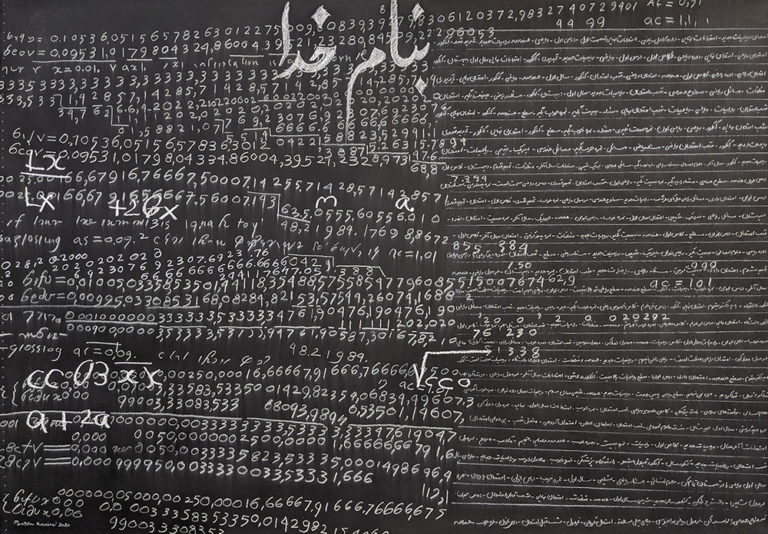Since 2014, Pantea Karimi’s work has been an exploration into the pages of medieval and early modern scientific manuscripts. Karimi’s current project reflects on her intensive science training in high-school with the aim of becoming a doctor; a goal that she abandoned to pursue an art career. This project revisits her interest in the topic through the lens of art.
White and branded footwear, bright-colored socks, and backpacks, polished nails, makeup kits, cassettes, and glossy posters of Western celebrities were the forbidden items that kept hundreds of teenage girls—who were otherwise sheathed in full hijabs—at the schoolyard before attending their classes. The long lines and the frustrating process of searching for these items by the school authorities were to assure that everyone conformed to the rules of public life in the Islamic Republic of Iran. The story of coming-of-age in post-revolutionary Iran is accompanied by the pressure placed on the youth for excelling in mathematics, arguably the most esteemed subject of study in Iran.
The Unbearable Lightness of Mathematics is Pantea Karimi’s personal story of four years of science education in the late 80s under the Islamic Republic of Iran.
For this solo exhibition at the Mercury 20 Gallery, Karimi has made a series of mock blackboards animated by chalk-written mathematical formulas topped with the phrase In the Name of God in Persian as well as the iconic headshots of Iran’s revolutionary leaders. The black thread formation and marked spots on the floor are reminders of the long lines in her schoolyard and the atmosphere she experienced every morning before her class. Ironically these demarcations are also familiar during the COVID-19 pandemic. Coupled with a few “forbidden” objects mounted amid the gallery, Karimi reconstructs her Iran’s science classroom of the 1980s. While a personal story, this exhibition connotes a restrictive educational system that did not leave much room for focused-learning or personal explorations. This poignant anxiety is captured through the gradual fading of the contents of the mock blackboards. Mathematics was, indeed, too abstract and aloof to stimulate the articulation of subversive thoughts, artistic sentiments, and socio-political views. Unbearably “light” for the “heavy” environment in which it was taught, mathematics is both the agonizing and the celebrated protagonist in this exhibition.
Bio: Pantea Karimi is an Iranian-American multidisciplinary artist, based in the San Francisco Bay Area. Her works explore the intersection of art, history, and science and examine how the broader aesthetic considerations of science are closely related to art. She researches illustrations and texts of medieval Persian, Arab, and early modern European scientific manuscripts. Utilizing conceptual and visual interpretations from her research, she creates individual bodies of artwork using interactive installations, VR, silkscreen, digital illustrations, and prints. Pantea Karimi has exhibited her works in diverse solo, group, and traveling exhibitions in Iran, Algeria, Germany, Croatia, Mexico, the UK, and the United States. Her works are held in private and public collections including Stanford University, the UC Davis Medical Center, and the University of California, San Francisco. Her print, graphic design works, and installations have been featured in several publications in Iran, Italy, Croatia, the UK, and the United States including the British Library blog, SF/Arts, and the KQED. Karimi is the recipient of the 2019 City of San Jose Arts and Cultural Exchange Grant; the 2019 Silicon Valley Artist Laureates Award; and the 2017 Kala Fellowship-Residency Award. She is an Adjunct Faculty in the digital media and studio art departments at the College of San Mateo and the Cabrillo College.
